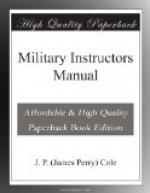enfilade the entanglements of the first line. They
concentrate the fire effect of from 7 to 10 riflemen.
Effective range: up to 300 yards.
(c) Rifle Grenadiers. Located near enough to first line to hold
the enemy trenches under fire and deliver effective barrages
near the mouths of our own communicating trenches. Should be
located near observation posts so that their fire can be
promptly corrected.
(d) Trench mortars. Located similarly to (c). Manned by
riflemen.
(e) Bombers. One supply man to each 2 grenadiers. Used for
protection of auto-rifles, in counter attacks, for
protection of communicating trenches and fighting in close
quarters.
(f) Riflemen. Posted to deliver frontal fire. Grouped according
to the plan of counter attacks.
(g) As many men as possible should be instructed in the use of
the enemy’s weapons.
D. LIAISON:
(a) By telephone.
Quickest and most accurate. Maintained
between
each platoon and its company headquarters, and
between
adjoining companies. Especially subject to
destruction
in bombardment. Wireless and ground telegraphy
are
used only between brigade and division headquarters.
(b) By runners
("liaison agents"). Five detailed from each
company
to battalion headquarters; one sent to each
adjoining
company headquarters; one from each platoon to
company
headquarters; four or five on duty at each platoon
headquarters;
five from each machine gun company to
battalion
headquarters. Messages sent by them should, if
practicable,
be written and signed, and should be receipted
for
by the addressee.
(c) By rockets
and flares. Quickest means of liaison with the
artillery
in rear.
(d) Domestic (message
carrying) grenades.
(e) Dogs and carrier
pigeons. Sent out to the rear from
battalion
headquarters.
(f) One searchlight—with
a radius of 3 miles—is furnished to
each
company.
(g) Noise.
Klaxon signals, etc., give warning of gas attacks.
E. OBSERVATION:
(a) Observers:
1. Must be men of infinite patience,
keen hearing and
eyesight.
2. They are located behind the first
line in positions
combining good view with concealment.
3. Each is provided with a panoramic
map, made from
aeroplane photographs, of the enemy’s
trenches. On this
must be promptly noted every slightest
change in the
trace, height of parapet, etc.,
of the enemy’s line. Such
notes greatly assist in locating machine




